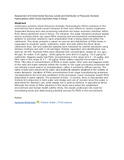| dc.contributor.author | Shitandayi, Agripina | |
| dc.contributor.author | Orata, Francis | |
| dc.contributor.author | Lisouza, Fred | |
| dc.date.accessioned | 2021-06-09T07:08:47Z | |
| dc.date.available | 2021-06-09T07:08:47Z | |
| dc.date.issued | 2019-06 | |
| dc.identifier.uri | https://doi.org/10.4236/jep.2019.106046 | |
| dc.identifier.uri | https://www.scirp.org/journal/paperinformation.aspx?paperid=93157 | |
| dc.identifier.uri | http://r-library.mmust.ac.ke/123456789/1648 | |
| dc.description.abstract | Continuous concerns about Polycyclic Aromatic Hydrocarbons (PAHs) presence in the environment have raised concern because of their toxic effects to various organisms. Sugarcane farming and cane processing industries are major economic activities within River Nzoia catchment area in Kenya. For instance, the sugar industries produce wastes and by products which can cause PAHs emission and environmental contamination in addition to activities related to rapid urbanization that is being observed within the catchment. This study presents a report on sources and distribution of PAHs levels in sugarcane by products waste, sediments, water and soils within the River Nzoia catchment area. Soil and sediment samples were extracted by soxhlet extraction using dichloro-methane and with C-18 catridges. Analyte separation and identification was done by GC-MS. Fourteen PAHs were detected with concentration ranges of; 0.6 μg/L - 80 μg/L for water, 0.01 μg/kg - 1200 μg/kg for soils and 0.13 μg/kg - 19.6 μg/kg for sediments. Bagasse waste had PAHs concentrations in the range of 0.4 - 14 μg/kg, and filter cake in the range of 1.7 - 30 μg/kg. Boiler waters reported the presence of 8 PAHs. The ratio of concentrations of PAHs in boiler water, filter cake and bagasse waste to the soils and water samples within the vicinity to the sugar processing companies did not indicate a point source of contamination; rather it pointed to diffuse sources. The same results were observed for water and sediment samples obtained in the vicinity of waste dumpsite. Variation of PAHs concentrations from sugar manufacturing processes corresponded to the kind and conditions of the processes. Lower molecular weight PAHs dominated in water sample. The presense of benz: 1) pyrene, benz 2) flourancene and Indeno(123,cd)pyrene in both water and sludge soils are of concern since this water is abstracted for domestic use, while sludge soil is used as fertilizer in agricultural farms. Although the levels of PAHs obtained in this study were below the established environment and human health safefty limits, the results underscore the need for mornitoring levels and determining potential sources for PAHs in the environment. | en_US |
| dc.language.iso | en | en_US |
| dc.publisher | Journal of Environmental Protection | en_US |
| dc.subject | Assessment, Environmental ,Sources, Levels, Distribution, Polycyclic, Aromatic ,Hydrocarbons | en_US |
| dc.title | Assessment of Environmental Sources, Levels and Distribution of Polycyclic Aromatic Hydrocarbons within Nzoia Catchment Area in Kenya | en_US |
| dc.type | Article | en_US |

